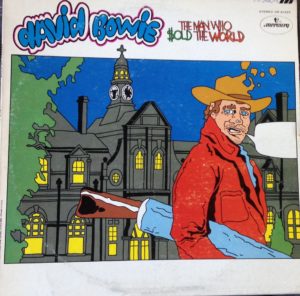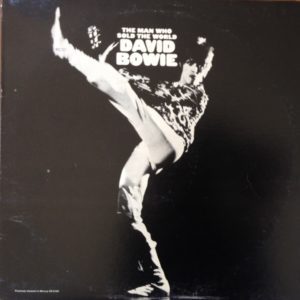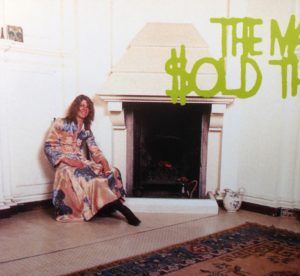
Often overlooked in David Bowie’s early catalog is The Man Who Sold The World, his third album and follow up to what most people consider his first major album- the originally self titled David Bowie, later released as Space Oddity. A departure from the mostly acoustic David Bowie, TMWSTW is much more of a hard rock record and alludes to what Bowie would be doing 2 years later on Ziggy Stardust. It also marks the beginning of his collaboration with guitarist Mick Ronson who along with bassist and producer Tony Visconti provided most of the arrangements.
TMWSTW was originally released in the US in 1970 to modest success. It was released in the UK in 1971 with even less fanfare. Drafting on the huge successs of Ziggy Stardust a year later, TMWSTW was re-released and reached 105 on the Billboard album charts in the US and 25 on the UK Albums Chart. TMWSTW was a significant influence on bands ranging from The Cure in the 1980’s to Nirvana in the 90’s. Nirvana‘s performance of the title track on MTV Unplugged and the album recorded during that performance and released in 1993 no doubt revived interest in TMWSTW for a younger generation.
This album entered my consciousness via the cover art. As my passion for David Bowie blossomed during college I recall seeing copies of the album with the cartoon cowboy and being intrigued by it. It’s so different from the cover art for any of his other albums. When I finally bought my first copy however it was the RCA reissue with what’s known as “the kick” cover.

I hadn’t owned the record very long when in a rare act of carlessness I left it in my car on a hot day and it warped. The first 2 tracks on each side became unplayable. It was 10 years before I bought another copy.
That copy, a 2001 reissue from Simply Vinyl, comes with cover art from the original UK version and includes an insert with photos from a shoot Bowie did just before the album’s release. Most of these photos were taken at Bowie’s residence at the time, a converted eduardian mansion in Beckenham, London.
Although the setting is very personal, Bowie looks overly posed and stiff in these photos. Lounging in his satin “man’s dress” with a playing card stuck between his fingers he looks like a cross dressing gypsy. Still, as a fan it’s fun to see these photos and feel something of a personal connection to the man at the time he created this wonderful album.
While much of TMWSTW is a very hard rock album, I’ve always particularly liked the title track. With it’s latin rhythms and dystopian theme it’s a song that captures the imagination.
 For years I really enjoyed what Simply Vinyl’s remastering had done for this song. The percussion is very up front and crisp on this record and the vocals occupy a huge part of the soundstage. It’s a digitally remastered sound that had a lot of appeal when the gear I was playing it on couldn’t provide the necessary depth and transparency to reveal it’s spaciousness or bottom end.
For years I really enjoyed what Simply Vinyl’s remastering had done for this song. The percussion is very up front and crisp on this record and the vocals occupy a huge part of the soundstage. It’s a digitally remastered sound that had a lot of appeal when the gear I was playing it on couldn’t provide the necessary depth and transparency to reveal it’s spaciousness or bottom end.
If I’m passionate about a record, these days I want to hear more than one version and try to get the best copy I can without spending a small fortune. A little research led me to the first US pressing which, while by no means cheap, doesn’t sell for the eye popping figures it’s UK counterpart fetches.
The relative affordability of the first US pressing may be partly due to the existence of a counterfeit version that is quite common in the used market. I discovered this counterfeit version is often listed side by side with the real originals. This version can be identified by the runout matrix, which is etched. The actual first US pressings have a stamped matrix. When I went looking for a copy I had to send out a lot inquiries to sellers about this runout matrix, and a number of responses came back saying that the copy in question had an etched matrix. I finally got the response I was looking for on a copy in nice condition on Ebay so I started bidding on it.
I don’t regret buying the record, but can I just say that I hate the buying experience on Ebay for collectible records. It’s just too stressful! I was up against one other bidder and I managed to discern his high price and bid over, but my blood pressure suffered for it. Thankfully this copy has not been a disappointment.
As I started listening to my copies of TMWSTW I began making notes on what I was hearing. Here are some of my observations:
“Width of a Circle”
On the Simply Vinyl reissue the guitars have a “jangly” sound that strikes me as metallic. The vocals are very clear, especially the backing vocals.
On the US pressing the guitars sound more natural, as do the vocals which match the Simply Vinyl in clarity. The bass guitar on the US is HUGE and rumbling with a bigger, deeper soundstage. Overall the sound of the US is more size and power compared to the Simply Vinyl on which the music is more tightly presented.
“All the Madmen”
Again, on the US pressing the bass guitar is HUGE, the drums also sound huge and fill the whole soundstage. The soundstage is deep, the guitars scream and the keyboard sings.
On the Simply Vinyl the drums have more a bit more pop and the guitar screams a bit more harshly. There’s great detail to the vocals, significantly less bass and the percussion gets a bit bright.
“Black Country Rock”
The original US again has the big sounding bass and drums. The vocals sound relaxed and there’s space around the percussion instruments.
The Simply Vinyl is just harsh sounding on this track.
“Oh By Jingo”
The original US has a spaceous feel and the drums occupy that space deep in the soundstage.
The Simply Vinyl sounds flatter and it presses against the ear. Lots of detail in the vocals again, but there’s a sibilance to Bowie’s voice that is unpleasant at higher volume. The guitars on this version sound a bit wispy.
“She Shook Me Cold”
On the Simply Vinyl the symbols present as a major feature, but them seem mastered too loud, giving them a bright airyness that doesn’t integrate well with the rest of the drum kit. The midrange seems a bit muddled.
On the orig. US the symbols settle back into their place, although there could be more transparency on this version (or maybe just this copy).
“The Man Who Sold the World”
On the Simply Vinyl the guitar and percussion jumps out at you, as do Bowie’s vocals, which sound too big and overwhelm the track with a lot of sibilance. The drums sound shallow.
On the orig. US, even with the effects Bowie’s voice immediately sounds more natural, without the artificiality and sibilance present on the S.V. version. The guitars sound less “jangly” and more natural while the heavier drums and bass serve to anchor the songs lighter elements. It might sound a bit more muddled than the Simply Vinyl but is still far preferable.
“Supermen”
On the orig. US the Guitars just rock!
I think I just ran out of gas at this point. Doing a vinyl shootout is tedious work, even on a record that you really enjoy hearing over and over. There’s a lot of clamping and unclamping of records and a lot of focusing on the elements of the music and how each is presented.
The long and short of it, if you haven’t already figured it out, is that the Original US pressing basically kicks the teeth out of the Simply Vinyl reissue. It’s not even competitive. And with the price difference in the market between these two versions being within 30 or 40 dollars I’d say anyone looking to buy a copy of this record who is considering these two versions has a pretty clear choice. I have not heard the 2016 Parlaphone reissue, but I have heard several others from this batch of reissues and, with the exception of Ziggy Stardust I would have to say these overall are not great. It’s possible TMWSTW is an outlier among these, but I doubt it.